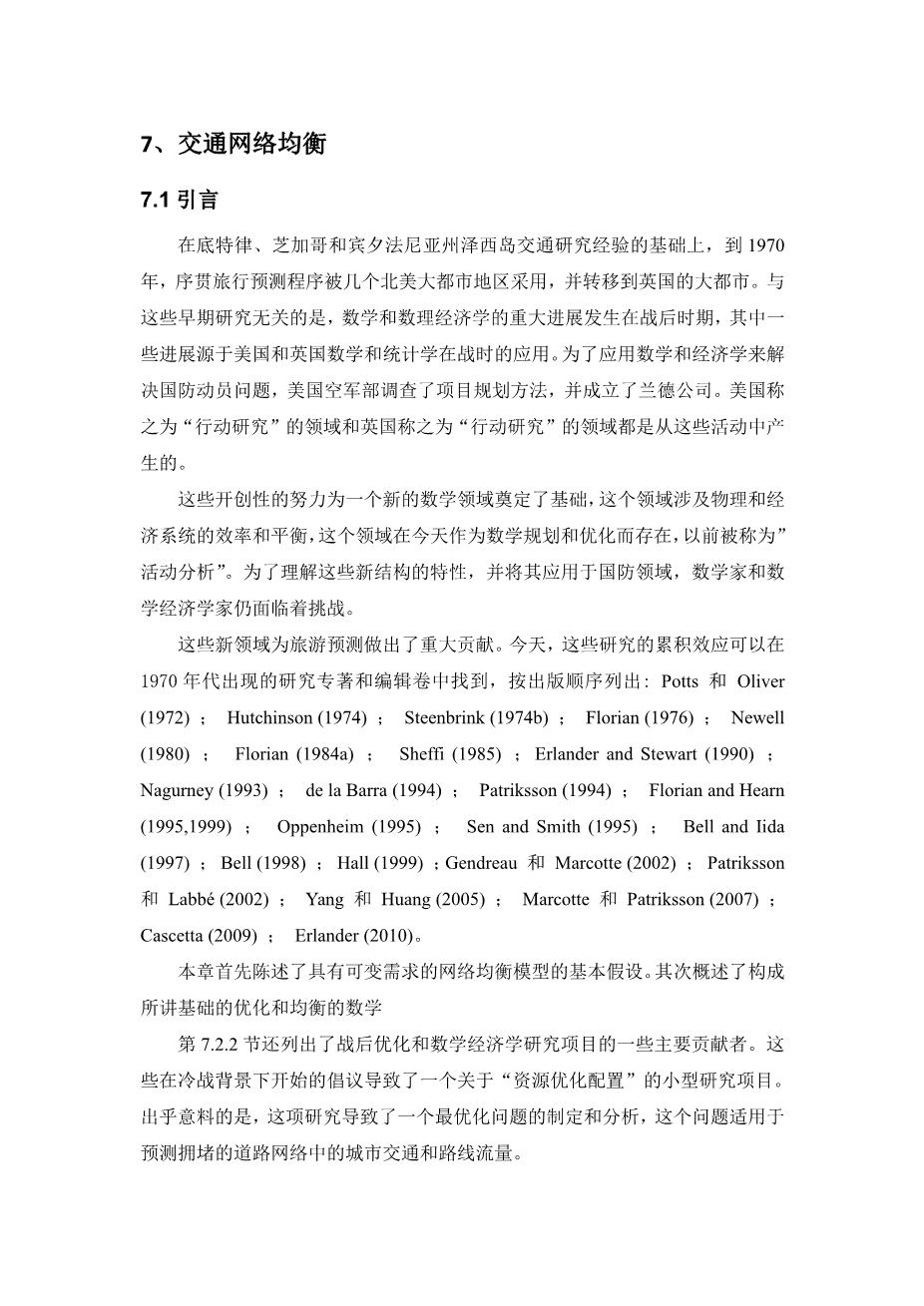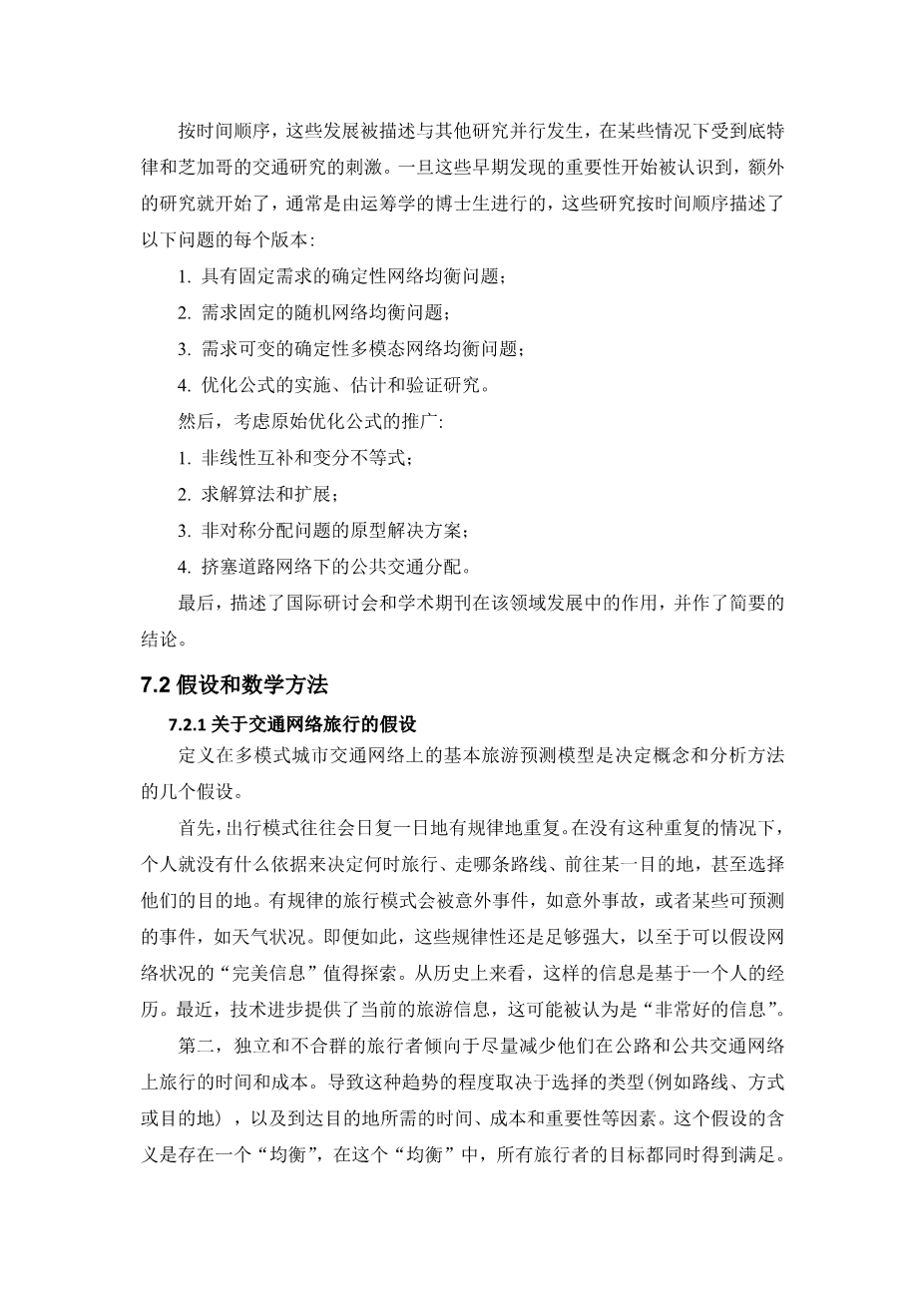7、交通网络均衡外文翻译资料
2023-04-08 22:54:29
7.emsp;Transportation network equilibrium
7.1INTRODUCTION
Building on the experiences of the Detroit, Chicago and Penn Jersey transportation studies, the sequential travel forecasting procedure was adopted by several North American metropolitan areas by 1970 and transferred to large conurbations in the UK (Chapters 2–3). Unrelated to these early studies, major advances in mathematics and mathematical economics occurred during the postwar period, some evolving from wartime applications of mathematics and statistics in the US and UK. Efforts to apply mathematics and economics to solve defence mobilisation problems led the US Department of the Air Force to investigate project planning methods and to establish the RAND Corporation.Fields called lsquo;operations researchrsquo; in the US and lsquo;operational researchrsquo; in the UK emerged from these activities.
These pioneering efforts laid the foundations for a new field of mathematics concerned with efficiency and equilibria of physical and economic systems, which exists today as mathematical programming and optimisation, and was formerly known as lsquo;activity analysisrsquo;. Research to understand the properties of these new constructs, and to apply them to problems of national defence, challenged mathematicians and mathematical economists.
The objective of this chapter is to trace developments emerging from these new fields, which led to major contributions to travel forecasting. Today, the cumulative effects of these lines of research are found in research monographs and edited volumes that appeared from the 1970s, listed here in order of publication: Potts and Oliver (1972); Hutchinson (1974); Steenbrink (1974b); Florian (1976); Newell (1980); Florian (1984a); Sheffi (1985); Erlander and Stewart (1990); Nagurney (1993); de la Barra (1994); Patriksson (1994); Florian and Hearn (1995, 1999); Oppenheim (1995); Sen and Smith (1995); Bell and Iida (1997); Bell (1998); Hall (1999); Gendreau and Marcotte (2002); Patriksson and Labbeacute; (2002); Yang and Huang (2005); Marcotte and Patriksson (2007); Cascetta (2009); and Erlander (2010).
The chapter begins with a statement of the assumptions underlying network equilibrium models with variable demand in section 7.2.1. Although similar to those found in Chapters 4 and 5, some are restated here so that this chapter is self-contained. Section 7.2.2 offers an overview of the mathematics of optimisation and equilibria that forms the basis for the chapter. Readers familiar with these concepts may omit section 7.2 without loss of continuity.
Section 7.2.2 also identifies some of the principal contributors to postshy;war research programmes in optimisation and mathematical economics. These initiatives begun in the context of the Cold War led to a small research programme on the lsquo;optimal allocation of resourcesrsquo;. Quite unexpectedly, this research resulted in the formulation and analysis of an optimisation problem suitable for forecasting urban travel and route flows over congested road networks.
Proceeding chronologically, these developments are described with other studies occurring in parallel, in some cases stimulated by transportation studies in Detroit and Chicago (Chapter 2). Once the significance of these early findings began to be recognised, additional research was undertaken, often by Ph.D. students in operations research. These studies are described chronologically for each version of the following problems:
1.deterministic network equilibrium problem with fixed demand;
2.stochastic network equilibrium problem with fixed demand;
3.deterministic multi-shy;modal network equilibrium problem with variable demand;
4.implementation, estimation and validation studies of the optimisation formulations.
Then, generalisations of the original optimisation formulation are considered:
1.nonshy;linear complementarity and variational inequality;
2.solution algorithms and extensions;
3.prototype solutions of the asymmetric assignment problem;
4.public transport assignment on congested road networks.
Finally, the roles of international symposia and academic journals in the development of the field are described, followed by a brief conclusion.
7.2 ASSUMPTIONS AND MATHEMATICAL APPROACH
7.2.1 Assumptions about Travel on Transportation Networks
Underlying travel forecasting models defined on multi-modal urban transportation networks are several assumptions that determine the conceptual and analytical approach.
First, travel patterns tend to repeat themselves regularly, day after day. In the absence of such repetition, individuals would have little basis for deciding when to travel, by which route, to a given destination, or even for choosing their destinations. Regular travel patterns are distorted by unexpected events, such as accidents, or by somewhat predictable events such as weather conditions. Even so, these regularities are sufficiently strong to make an assumption of lsquo;perfect informationrsquo; about network conditions worth exploring. Historically, such information was based on onersquo;s experience. Recently, technological advances have provided current travel information, which may be regarded as lsquo;very good informationrsquo;.
Second, travellers independently and non-cooperatively tend to minimise the time and cost of their journeys over road and public transport networks. The extent of this tendency depends on the type of choice (e.g., route, mode or destination) and the definition of time, cost and importance among other considerations. An implication of this assumption is the existence of an lsquo;equilibriumrsquo; in which the objectives of all travellers are simultaneously satisfied. In this chapter, we refer to this construct as a lsquo;network equilibriumrsquo;. An equivalent term is lsquo;user equilibriumrsquo;.
The objective of some travellers may be
剩余内容已隐藏,支付完成后下载完整资料


英语译文共 9 页,剩余内容已隐藏,支付完成后下载完整资料
资料编号:[590311],资料为PDF文档或Word文档,PDF文档可免费转换为Word




